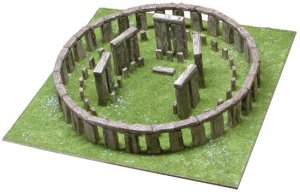
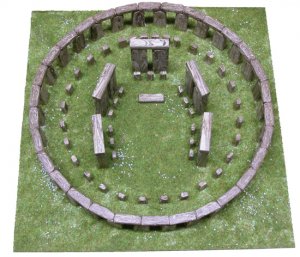
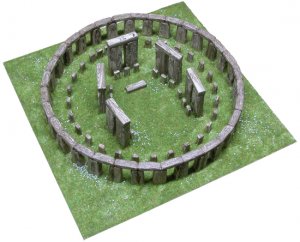
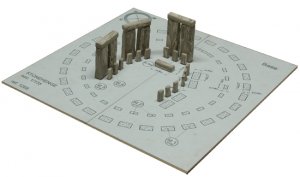
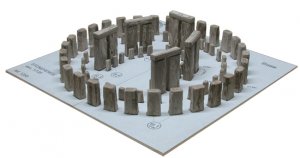
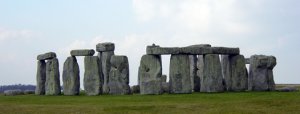






Ref.: AEDE-1268

Stonehenge The monument and its history Stonehenge is a prehistoric monument located in the English county of Wiltshire, about 3.2 kilometres (2.0 mi) west of Amesbury and 13 kilometres (8.1 mi) north of Salisbury. One of the most famous sites in the world, Stonehenge is composed of earthworks surrounding a circular setting of large standing stones. It is at the centre of the most dense complex of Neolithic and Bronze Age monuments in England, including several hundred burial mounds Archaeologists have believed that the iconic stone monument was erected around 2500 BC, as described in the chronology below. One recent theory however, has suggested that the first stones were not erected until 2400-2200 BC, whilst another suggests that bluestones may have been erected at the site as early as 3000 BC (see phase 1 below). The surrounding circular earth bank and ditch, which constitute the earliest phase of the monument, have been dated to about 3100 BC. The site and its surroundings were added to the UNESCO's list of World Heritage Sites in 1986 in a co-listing with Avebury Henge monument. It is a national legally protected Scheduled Ancient Monument. Stonehenge is owned by the Crown and managed by English Heritage, while the surrounding land is owned by the National Trust. Archaeological evidence found by the Stonehenge Riverside Project in 2008 indicates that Stonehenge served as a burial ground from its earliest beginnings. The dating of cremated remains found on the site indicate burials from as early as 3000 BC, when the initial ditch and bank were first dug. Burials continued at Stonehenge for at least another 500 years. The number of postholes dating to the early 3rd millennium BC suggest that some form of timber structure was built within the enclosure during this period. Archaeological excavation has indicated that around 2600 BC, the builders abandoned timber in favour of stone, and dug two concentric arrays of holes in the centre of the site. These stone sockets are only partly known; however, they could be the remains of a double ring. During the next major phase of activity, 30 enormous Oligocene-Miocene sarsen stones were brought to the site. They may have come from a quarry, around 40 kilometres (25 mi) north of Stonehenge on the Marlborough Downs, or they may have been collected from a "litter" of sarsens on the chalkdowns, closer to hand. The stones were dressed and fashioned with mortise and tenon joints before 30 were erected as a 33 metres (108 ft) diameter circle of standing stones, with a ring of 30 lintel stones resting on top. The lintels were fitted to one another using another woodworking method, the tongue and groove joint. Each standing stone was around 4.1 metres high, 2.1 metres wide and weighed around 25 tons. Each had clearly been worked with the final visual effect in mind; the orthostats widen slightly towards the top in order that their perspective remains constant when viewed from the ground, while the lintel stones curve slightly to continue the circular appearance of the earlier monument. The inward-facing surfaces of the stones are smoother and more finely worked than the outer surfaces. The average thickness of the stones is 1.1 metres and the average distance between them is 1 metre. A total of 75 stones would have been needed to complete the circle and the trilithon horseshoe. Unless some of the sarsens have since been removed from the site, the ring appears to have been left incomplete. The lintel stones are each around 3.2 metres, 1 metre wide and 0.8 metres thick. The tops of the lintels are 4.9 metres above the ground. The Heel Stone lies just outside the main entrance to the henge, next to the present A344 road. It is a rough stone, 16 feet (4.9 m) above ground, leaning inwards towards the stone circle. It has been known by many names in the past, including "Friar's Heel" and "Sun-stone". Today it is uniformly referred to as the Heel Stone or Heelstone. When one stands within Stonehenge, facing north-east through the entrance towards the heel stone, one sees the sun rise above the stone at summer solstice. Throughout recorded history Stonehenge and its surrounding monuments have attracted attention from antiquarians and archaeologists.